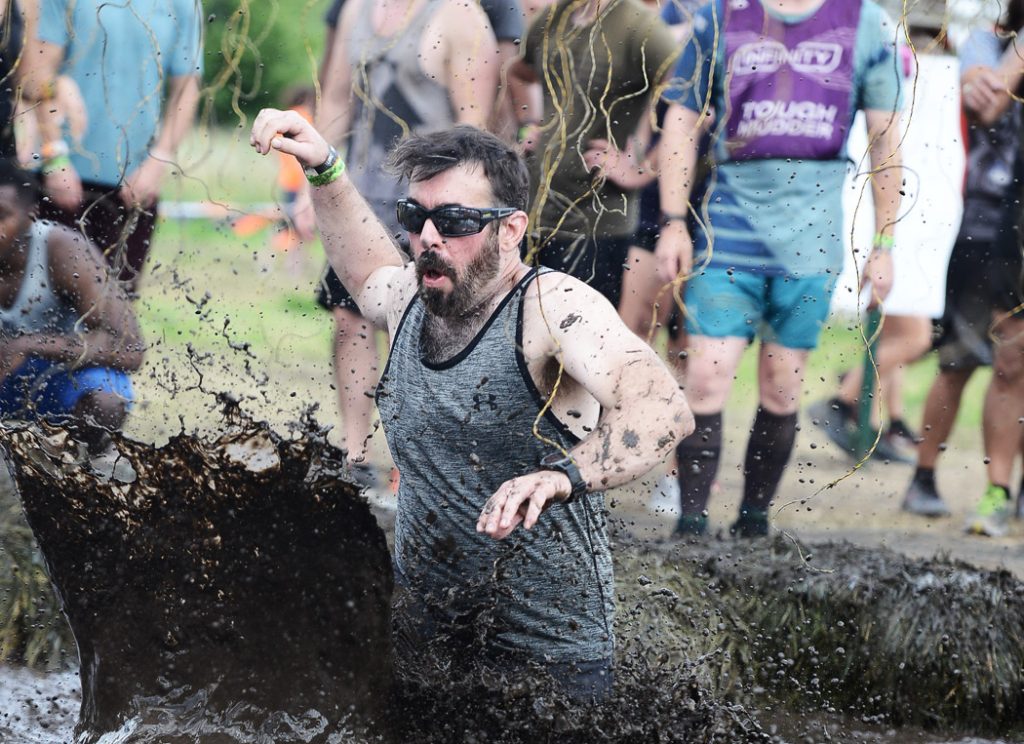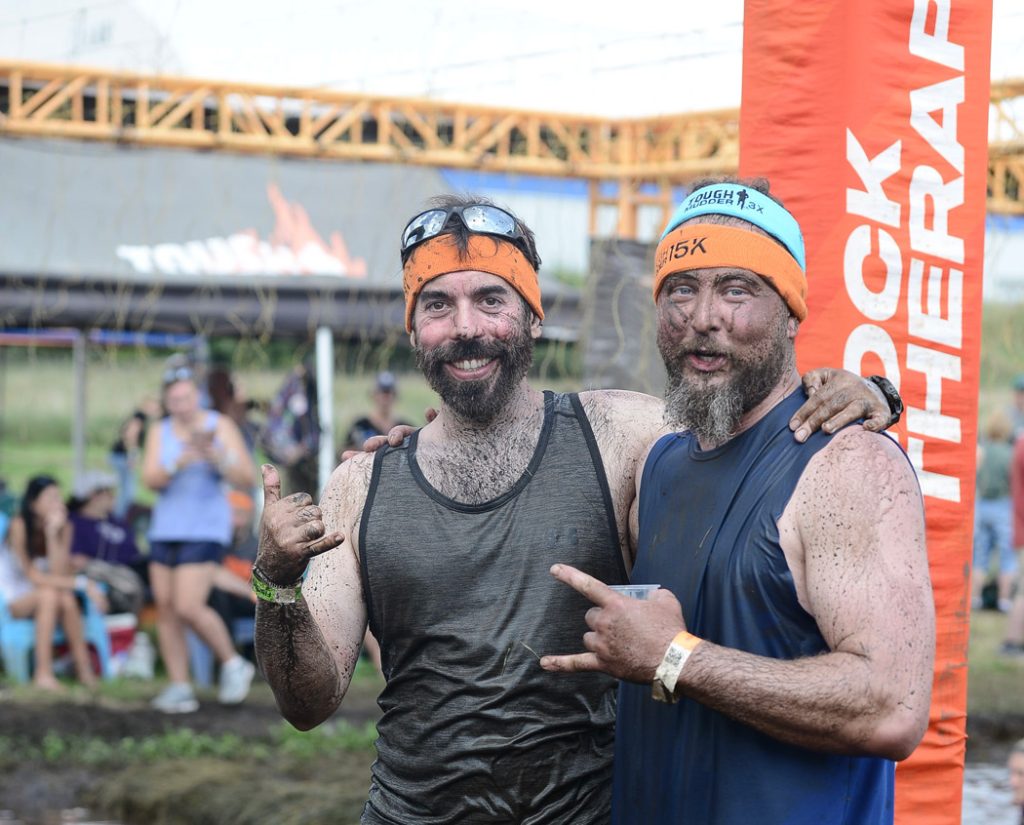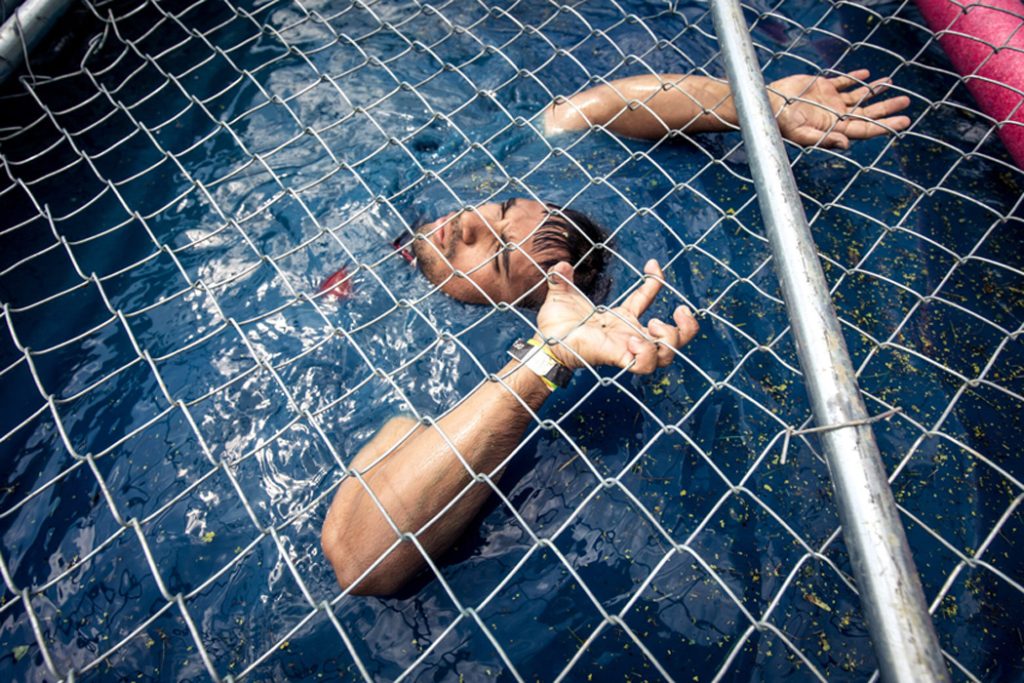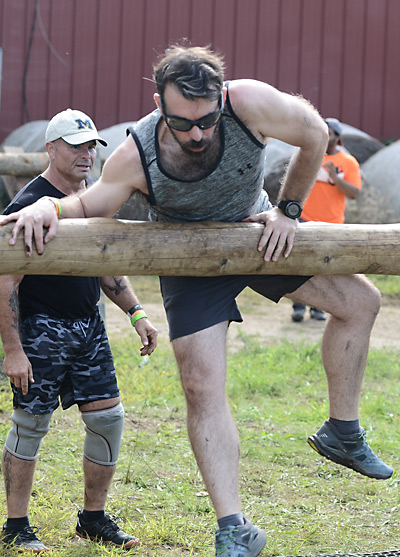
Across the United States, athletic adventurers set their sights on conquering the perils of the natural landscape and testing the limits of human physiology with freakish feats of freestyle rock climbing, steep-descent mountain biking, and white-knuckle rapids rafting. Surfing, spelunking, and triathlons that take an entire day.
Here in the Midwest, even though we have fewer cliffs, fewer caves, and fewer waves, we still find extreme ways to entertain ourselves. Because we have a couple things going for us: 1) The sheer power of our stubborn, middle-state wills, 2) Friends who will cheer us on when we decide to try something stupid, and 3) Mud. (Just add water.)
I sat down with Eric Johnson—dedicated thrill seeker, avid runner, marketing consultant, and board president of the Fairfield CoLab nonprofit—to grill him about his recent experience in the Tough Mudders Obstacle Run, taking place this September just outside of Rockford, Illinois. Lying somewhere in the intersection of American Ninja Warrior, military boot camp, and your kids’ backyard playset after a monsoon, Tough Mudders is just one of several obstacle-course purveyors providing adventurous souls with some seriously dirty fun—and destroying athletic shoes from coast to coast.

Eric was coaxed into “Mudder Nation” by his friend Matt Kendz, who in recent years had done 5K and 10K versions of the event. Being the adventure junkie he is, Eric jumped right into the Classic Tough Mudder, a 15K. With 9-plus miles of running and 30 obstacle challenges bearing humorous but intimidating names like “Arctic Enema,” “Berlin Wall,” “Dirty Ballerina,” and “Dong Dangler”—some of which are gruelingly hard—I imagined the average Jane or Joe would be hurting pretty bad by the end—or missing some limbs. Eric and Matt, however, lived to tell the tale, and are already strategizing for next year’s run. They’re hooked.
As a primer for our convo, Eric shared a video created by another runner in his event—same day, different heat. Body cam footage, set to a blood-pumping percussive soundtrack, provided me with an up-close look at what these mudders were up against. Barbed-wire army crawls. 40-foot-tall net ladders. Wall climbs that require a full-body pull-up. My first impressions were along the lines of, “What are these people thinking!?” But repulsion quickly became fascination, and by the end of the video I was wondering, “Could I do this?”
“Oh, totally,” Eric tells me. “A lot of people start with the 5K.” The entry-level Tough Mudder is a short walk/run done at any pace you want, interspersed with a few favorite obstacle features, and—as is the case for all Tough Mudder events—any of them can be skipped. “Matt thinks it’s just enough to whet your appetite,” Eric tells me, “and gets you excited to do more,” but they both advise that if you’re traveling half a day to get there, you may as well sign up for the 10K to make the trek worthwhile. In the coming year, Tough Mudders will be hosting Midwest runs in Illinois, Missouri, Michigan, Minnesota, and Wisconsin.
Eric prepared for his first event with a running regime, “but didn’t do any strength work.” He’d been out of the gym since Covid began, so he went into the event planning to skip some obstacles. “I knew some of the climbing and monkey bar ones would get me.” Grip strength is a real factor for some of these near-gymnastic feats. On the flip side, Matt focused heavily on strength training. “He wasn’t prepared for the running as well as I was,” says Eric, “so I slowed my pace and we made it work—but a big goal for Matt was to do a lot of the obstacles he couldn’t finish last time, and he succeeded.” Their goal for next year “is to have everything dialed in.”
Mental Toughness
Even for a doughier person like myself, some of the Tough Mudder obstacles did seem doable, but there is a mental aspect to this non-race race that the video I saw made quite clear.
“Some of the obstacles seem psychologically … weird!” I told Eric. “That one where you have to float on your back and pull yourself through a pool of dirty water covered by a horizontal chain-link fence—with only enough room above water to exposed your face? Yuck!!”

“That was my favorite one!” says Eric. I was learning a lot about the dude. “So fun! Yeah, you pull yourself along about 50 feet or so with only your nose and lips above water.” (Ack!!) “But for Matt? That was one of his least favorites. He kinda started, and then got a little spooked and had to start again. You can’t see where you’re going, and you don’t really know when it’s gonna end. But I liked that one!”
Apart from a few river-slogging challenges, most of the water obstacles feature a pit lined with rubber and filled with dyed water. It gets downright dirty in there.

Eric gave me an overview: “There are climbing obstacles; then there are these raw, upper-body-strength obstacles, monkey bars kind of stuff; then the water obstacles, more psychological than anything else; and then there’s some filler—probably a quarter of the obstacles were vaguely based on bootcamp, not really that hard, not much to them, but something to break up the run. I thought the climbing ones would be my favorite because I used to be a more active rock climber, but the psychological water ones turned out to be the most fun!”
A quick visit to ToughMudders.com impressed upon me that facing one’s heeby jeebies is a motivating factor for some joiners—whether they’re scared of heights, water, filth, or physical exhaustion—or they’re conquering a fear of the unknown.
“There was this other water one—a plunge,” Eric adds. Dubbed the Arctic Enema, “you climb up a ramp and slide down the other side into deeeeep water.” Matt and Eric didn’t see the descriptive sign for it and went in, well … cold. “Shockingly cold. Super dark and super cold. That was unexpected.”
Sound dangerous? As you would hope for such a well-organized outfit, the deep-water features are manned by lifeguards in case somebody really gets in over their head. And “with EMS and police around the perimeter, and medics throughout the race space,” there is quite a lot of support. Surprisingly, our Iowa duo encountered only one injured athlete out of the “thousands and thousands” they passed.
At the event start, a Hype Man lays out all the ground rules for the participants embarking on their runs in spaced-out heats all morning, rules like “be nice, help people out around you, put your arms up like an ‘x’ if somebody’s hurt, stuff like that,” Eric says. And of course the Hype Man’s job is also to get everybody psyched for the run, which, for Eric and Matt, ended up being about four hours, start to finish. Their journey included plenty of water and port-a-potty breaks, and pausing occasionally at the most amusing obstacles, because “sometimes you wanna stand and watch people fall in the mud and stuff.”
That said, when push came to literal shove, there were very few muddy tasks the duo didn’t complete. “The only one that both of us skipped was a carrying one,” says Eric. “You carry your buddy on your back for a while, and then switch off. It was early on, and we didn’t want to blow out our ankles. It didn’t look fun enough to be worth, like, risking the whole run.”
Spontaneous Teammates
Speaking of partnering up, I was impressed that so many obstacles seemed designed to foster a help-your-buddy mentality. Some runners go with a whole posse dressed in matching garb and support each other through all the hardest moments.
“You can definitely go alone,” Eric tells me, “but there are obstacles that are impossible to finish without teamwork—so you’re working with whoever’s there.” He describes an obstacle that featured rectangular logs on an axis in water. “You’re in about five feet of water, so if you try to crawl over the log, you just pull the thing towards you and never make it. You have to have someone on the other side offering a reverse force—then when you get to the top, you shift your weight and you’re pulling it down for the next person.”
Another obstacle requiring extra support is an inverted climb up and over a tall paneled wall that’s tilted back toward you, a seriously difficult challenge. “And people were just helping whoever was there,” Eric recalled, “leaning over and giving a hand, or pushing people from underneath. And mostly it’s just random people helping each other.”
The athletes want each other to succeed out there. Eric says some of them won’t let you give up and will literally put their hands under your butt or feet—or offer a knee or their shoulders for a boost.
The event seems cooperative, not competitive, which I imagine takes a lot of the pressure off and sets a pretty positive tone.
“Nobody’s timing you,” says Eric, “you don’t have a number, there’s no rank. If you do want to race it, you can opt to join the Infinity Racers. They’re timed, and they’re also time-penalized if they skip obstacles or can’t complete them. But 99 percent of the people are just doing it for fun.” A very particular, very filthy kind of fun, right up through the final haul.
One Last Push
“The very last obstacle was shocking,” Eric said. “Like, it literally shocks you with electricity. I loved that one.” (No surprises there, I guess!) “You run through a mud pit, and there are all these electrodes hanging down, and when you touch them you get shocked. That was so funny … ” (Funny? I was waiting to see where the heck he was going with this.) “It was so funny because every single woman coming through got down on her belly and crawled under the electrodes and didn’t get shocked, and just got covered in mud. And every single dude, including me and Matt, just charged straight through.” (Take a look at the photo up top! See the electrodes?) “And we didn’t realize that there was a deep spot in the middle, so without fail, just fell onto our faces in the mud. And I got shocked the moment I stood back up—it was a pretty stout shock, too! Once we were through, we just stood and watched for a while. And I swear every girl avoided the electricity, and every guy ran through and fell on his face and then got shocked. It was an experience!” Hearing this made me proud to be a woman, I’ll admit.
Eric tells me that the “Electric Shock Therapy” obstacle is one of three “most famous” features of the Tough Mudder event. This trio of uber-challenging signature obstacles is sequenced at the end of each course as a grand finale—followed by a giant pile of voluntarily discarded sneakers, a rite of passage for exhausted warriors of every ilk who’ve just earned themselves a new title with a capital T and a capital M.
Do you have what it takes to be a Tough Mudder? Is this your next thing? Who knows, you might shock yourself.
